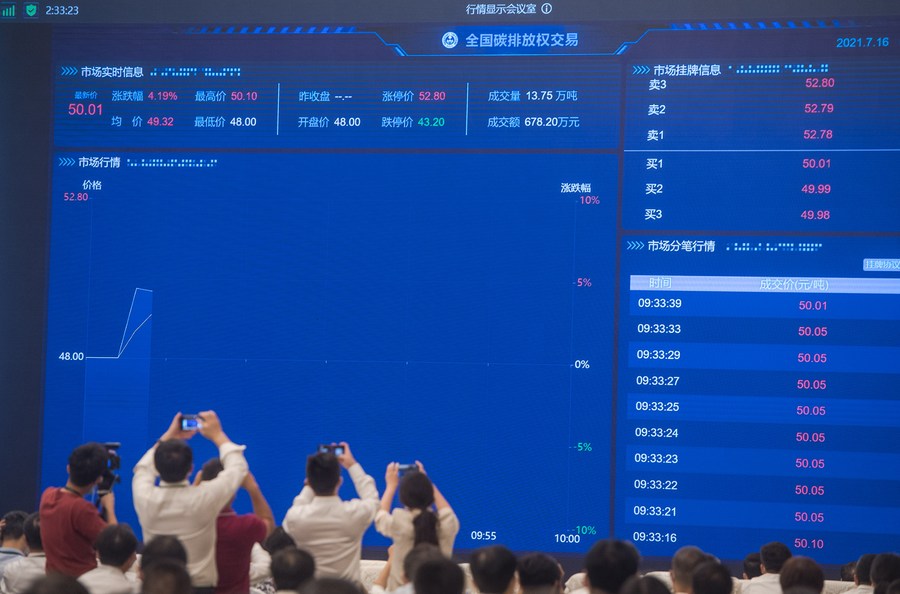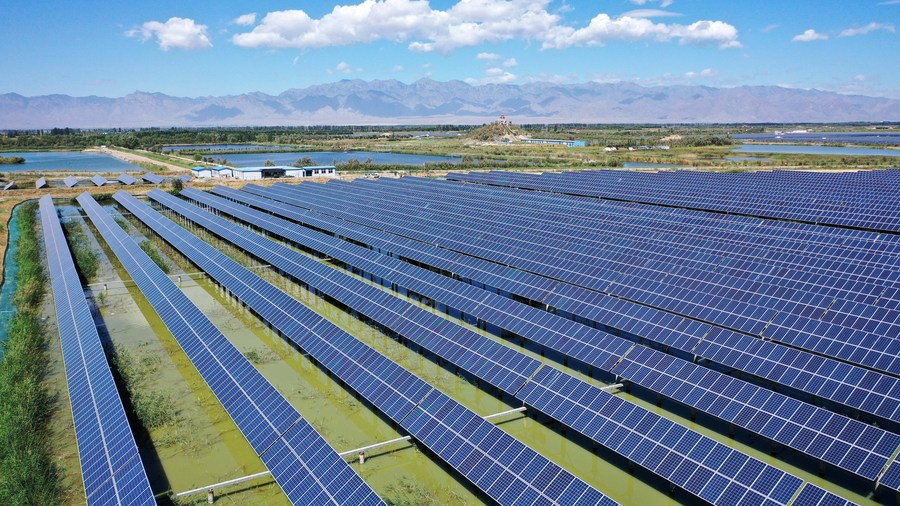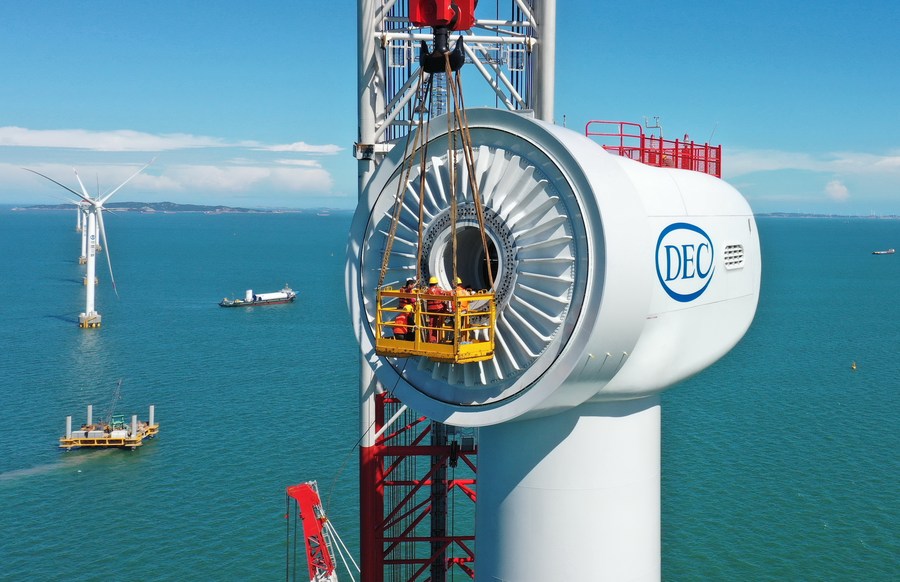-- while maintaining an effective policy mix to spur green investment, china is working towards a policy system that supports financing activities in a market-based way, and has made efforts to help developing countries cope with climate change and promote global efforts in green transition.
-- to facilitate green finance, china has combined top-down and bottom-up approaches to ensure that the government plays a guiding role while the market plays a decisive role in resource allocation.
-- the next five years will be a critical period in achieving china's carbon goals, and the central bank will continue to lay the ground for the green finance framework via ways including supporting a national carbon accounting system and improving the green finance standards.
with climate change posing risks to all, green finance is looming large on the agenda of policymakers and regulators worldwide as huge investments are required to fuel the global transition to a low-carbon economy.
in china, where the government aims to peak carbon dioxide emissions by 2030 and achieve carbon neutrality by 2060, it is estimated that tens of trillions of dollars are needed to fulfill this climate objective, but government funds alone will only cover a fraction of the demand.
where do such massive investments come from? what roles can policymakers and regulators play in pushing the transition? a look into china's green finance efforts, which helped build the country into the world's largest green loan and second-largest green bond markets, may shed some light.
china, while maintaining an effective policy mix to spur green investment, is working towards a policy system that supports financing activities in a market-based way, and has made efforts to help developing countries cope with climate change and promote global efforts in the green transition.

photo taken on july 16, 2021 shows a screen displaying real-time information of national carbon emission trading in wuhan, central china's hubei province. (xinhua/xiao yijiu)
top-down plus bottom-up
in 2016, the people's bank of china (pboc), china's central bank, led cross-department coordination to introduce a guideline on building a green financial system, which is the world's first green financial policy framework approved and established by central government departments.
"green development will not be achieved with government efforts or market forces alone," lei yao, deputy head of the financial research institute of the pboc, the central bank, told xinhua.
in supporting green development, according to lei, finance has three key roles: leveraging financial resources into the sector via policy tools, boosting the financial system's capabilities against climate change-related risks and facilitating trading on the national carbon market.
to fulfill such roles, china has combined top-down and bottom-up approaches to ensure that the government plays a guiding role while the market plays a decisive role in resource allocation, he said.
china has advanced rapidly in developing its green financial system and markets. by 2020, green loans and green bonds in china totaled 1.8 trillion u.s. dollars and 125 billion u.s. dollars, respectively, ranking as the world's largest and second-largest.
in another step to help reduce carbon footprint, china's national carbon market, the world's largest in terms of the amount of greenhouse gas emissions covered, started trading in shanghai in mid-july.
at the local level, pilot zones of green finance reform and innovation have been established in six provincial-level regions. currently, the proportion of outstanding green loans in these regions has outpaced the national level by four percentage points.

aerial photo taken on aug. 24, 2021 shows photovoltaic panels at a fish breeding base in helan county of yinchuan, northwest china's ningxia hui autonomous region. (xinhua/wang peng)
pushing for global cooperation
"we've watched over the last few years how climate finance has moved into the mainstream of financial institutions, and china has helped, in many ways, to push that transition," said deborah lehr, vice chairman and executive director of the paulson institute.
in 2016, under china's g20 presidency, green finance was for the first time included on the g20 summit agenda. china also proposed the setup of a g20 green finance study group, which later expanded into the g20 sustainable finance study group.
the group is now co-chaired by the pboc and the u.s. department of the treasury, according to lei.
since china announced to establish the china south-south climate cooperation fund in 2015, the country has set up low-carbon demonstration zones and climate change adaptation and mitigation projects in developing countries to help improve their capabilities to cope with climate change.
china's experiences in green finance, including carbon markets and pilot zones, can inform future action at the intersection of finance with climate change and biodiversity protection, lehr has said.
lei said china has also worked with other economies such as the european union (eu) to develop global standards for green finance.
"we have accelerated the building of a standard system for green finance, making it 'domestically unified and internationally compatible' with a focus on climate, pollution control, and energy-saving," he told xinhua.
by introducing a new green bond project catalogue this year, chinese financial authorities have provided a standard definition of green bond projects, unifying standards across different domestic regulators and aligning better with international standards.
"the 2021 version, which no longer considers the clean use of coal as a green project, has been widely praised both at home and overseas," said lei, noting that the move is in line with china's emission reduction goals.

aerial photo taken on june 12, 2020 shows workers installing an offshore wind turbine at a wind farm in fuqing, southeast china's fujian province. (xinhua/lin shanchuan)
a green way forward
in a research report earlier this year, the national institute of financial research of tsinghua university calculated that the investment china needs annually in green and low-carbon projects is three times the demand estimated five years ago.
"china needs to, and will very likely, take more aggressive measures to further promote green finance," the report said.
it expects progresses to be made in areas such as stronger incentives for green finance and the harmonization of green finance standards in china and europe.
facing the 2030 and 2060 carbon goals, lei said the next five years will be a critical period in achieving them, and the central bank will continue to lay the ground for the green finance framework via ways including supporting a national carbon accounting system and improving the green finance standards.
other priorities on the pboc's agenda include enhancing information disclosure and strengthening prevention against climate risks.
"in the future, the pboc will gradually include climate-related risks into its macro-prudential policy framework," said lei.
he revealed that the pboc is working on a new key document on green finance after the 2016 guideline, and aims to cooperate with the eu and complete a common ground taxonomy on green finance within the international platform on sustainable finance framework this year.
"we will also encourage banks, equity investment institutions and fund management companies to make green and low-carbon investments overseas," he said.
